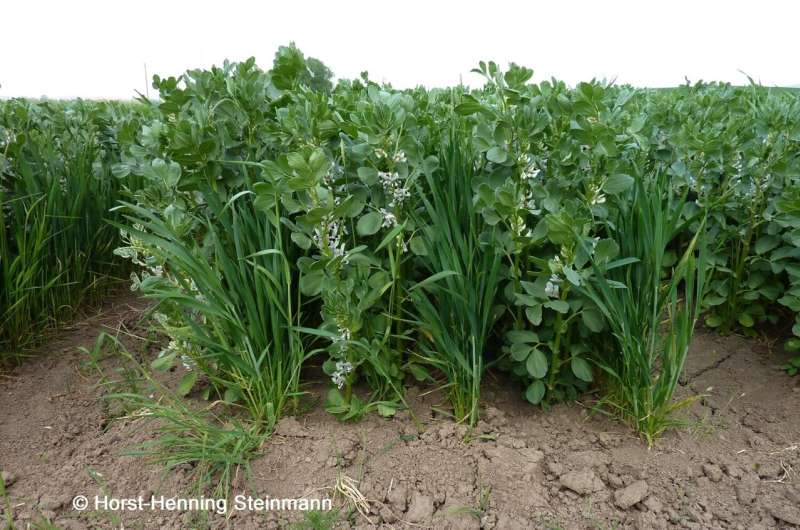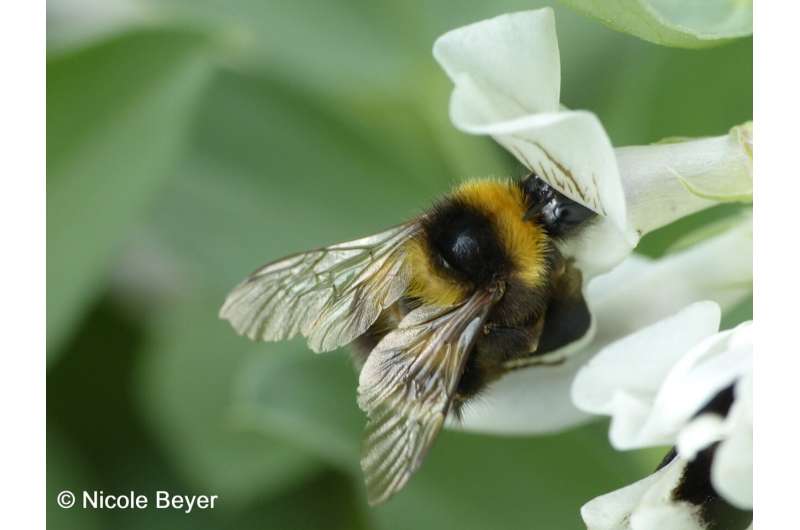A mixture of crops provides ecological benefits for agricultural landscapes, find researchers

There are often too few flowering plants in agricultural landscapes, which is one reason for the decline of pollinating insects. Researchers at the University of Göttingen have now investigated how a mixture of crops of fava beans (broad beans) and wheat affects the number of pollinating insects. They found that areas of mixed crops compared with areas of single crops are visited equally often by foraging bees. Their results were published in the journal Agriculture, Ecosystems & Environment.
The researchers observed and counted foraging honeybees and wild bees in mixtures of wheat and fava bean and in pure cultures that only contained fava beans. “We had expected that the mixed crops with fewer flowers would be visited less frequently by bees for foraging than single crops,” says Ph.D. student Felix Kirsch from the Functional Agrobiodiversity research group, University of Göttingen. “To our surprise, this was not the case.”
This could be due to several reasons. “Our mixed cultures were less dense than pure cultures, which possibly increased the visibility of the flowers. This might have attracted the similarly large number of bees to the mixed cultures,” suggests Dr. Annika Haß, postdoctoral researcher in the Functional Agrobiodiversity research group.

“In addition, reduced competition between the fava bean plants in mixed cultures could mean that they can invest more resources in the production of nectar and pollen to increase their attractiveness to bees,” adds Professor Wolfgang Link, head of the group for Breeding Research fava Bean.
“Mixed cultivation of wheat and fava bean has also other advantages for crop production,” says Professor Catrin Westphal, Head of Functional Agrobiodiversity. For instance, yields per bean plant were higher in mixed crops than in pure cultures.
“Cereal crops can be ecologically enhanced by adding legumes such as beans or lentils. This can make a valuable contribution to increasing the abundance of flowers on the arable land and thus counteracting pollinator decline,” concludes Haß.
More information:
Felix Kirsch et al, Intercrops as foraging habitats for bees: Bees do not prefer sole legume crops over legume-cereal mixtures, Agriculture, Ecosystems & Environment (2022). DOI: 10.1016/j.agee.2022.108268
Citation:
A mixture of crops provides ecological benefits for agricultural landscapes, find researchers (2023, January 20)
retrieved 20 January 2023
from https://phys.org/news/2023-01-mixture-crops-ecological-benefits-agricultural.html
This document is subject to copyright. Apart from any fair dealing for the purpose of private study or research, no
part may be reproduced without the written permission. The content is provided for information purposes only.
For all the latest Science News Click Here
For the latest news and updates, follow us on Google News.

